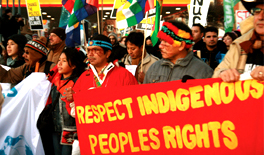Pricing forest carbon
Pricing forest carbon and putting in place the means and channels to pay for it are necessary conditions to achieve the 2030 mitigation goals. Yet, after more than 15 years of discussion, payments for
Pricing forest carbon and putting in place the means and channels to pay for it are necessary conditions to achieve the 2030 mitigation goals. Yet, after more than 15 years of discussion, payments for
The United Nations climate negotiations on reducing emissions from deforestation and degradation (REDD) provide a rare opportunity for conservation of tropical forests and biodiversity. Here, we explore the implications of REDD design and implementation options on biodiversity conservation and ways to link REDD with biodiversity conservation.
This paper reflects the state of the REDD negotiations at the end of the Copenhagen Climate Change Conference. The paper examines some of the main areas for moving ahead with REDD implementation, including principles and actions; measurement, reporting and verification (MRV); institutional arrangements; means of implementation and financing.
The impact of climate change will impose new costs on developing country exporters, especially if markets do not work correctly and international agreements are not well designed. If the costs of carbon emissions are priced correctly, then markets could ensure that emissions are reduced in the most efficient ways.
An agreement on reducing emissions from avoided deforestation and degradation at the UNFCCC Conference of the Parties 15 (COP 15) in Copenhagen December 2010 was not forthcoming. For a number of reasons this is a welcome outcome as several important outstanding legal and technical issues remain unresolved. This article examines the results from COP 15 including the Copenhagen Accord.
Developing countries would be more likely to participate in any new international climate change agreement if they could earn and trade carbon credits from avoided deforestation, also known as 'REDD'.
This paper explores the policy need and legal case for including social safeguards in a post-2012 agreement on reducing emissions from deforestation and forest degradation (REDD).
As the dust settles after Copenhagen and the barriers to reaching global consensus on combating climate change are put into stark relief, REDD still has potential to become a UNFCCC success story. In relation to REDD, there is agreement on many core issues and significant momentum remains towards a REDD mechanism firmly engrained in the post-2012 climate change framework.
In less than a generation oil palm cultivation has emerged as a leading form of land use in tropical forests, especially in Southeast Asia. Rising global demand for edible oils, coupled with the crop
The Ramsar Secretariat has released the report of the expert workshop "Achieving Carbon Offsets through Mangroves and Other Wetlands,

This is an analysis of the effects of growing forest carbon markets on tenure and indigenous rights by Rights and Resources Initiative. It takes stock of the current status of forest rights, assesses key issues of 2009 and identifies key questions and challenges that we will face in 2010.